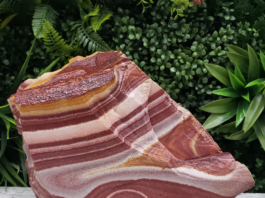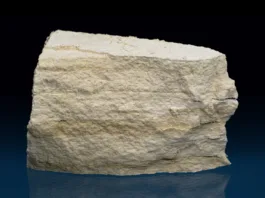Tufa is a type of porous limestone formed by the precipitation of calcium carbonate from water, often in environments where freshwater meets carbon-dioxide-rich waters, such as springs, streams, and lakes. Tufa deposits are typically found in areas with specific geological and hydrological conditions, making them both unique and valuable for scientific study. Their formation process, characteristics, applications, and locations provide insight into past climate conditions, ecological history, and even hold significance in cultural and architectural contexts.

Contents
Formation Process of Tufa
Tufa forms when calcium-rich groundwater reaches the surface and releases dissolved carbon dioxide into the atmosphere. This degassing process decreases the water’s ability to hold dissolved calcium carbonate, leading to its precipitation as calcite or aragonite, the two primary minerals in tufa. The process is influenced by factors such as water temperature, pH, the presence of organic matter, and biological activity, all of which contribute to the variety of textures and structures found in tufa.

Biological Influence on Tufa Formation
Bacteria, algae, and other microorganisms play a crucial role in the formation of tufa. These organisms help accelerate calcium carbonate precipitation by removing carbon dioxide during photosynthesis, which enhances calcite formation. Microbial mats are often found in tufa deposits, and their activity creates distinct patterns and textures within the stone. This biogenic influence is significant because it means tufa can form relatively quickly compared to other types of limestone.
Types of Tufa
Tufa is classified into various types based on its formation conditions, location, and physical characteristics. The main types include:
A. Hot Spring Tufa
- Formation: Occurs in areas with geothermal activity, where heated mineral-rich waters rise to the surface.
- Characteristics: Often contains unique mineral impurities, leading to distinct coloration and textures.
- Examples: Pamukkale in Turkey is famous for its stunning white terraces formed by hot spring tufa deposits.
B. River Tufa
- Formation: Develops in freshwater rivers, typically where plant life and algae are abundant.
- Characteristics: Generally more delicate and can form intricate structures around vegetation.
- Examples: Tufa formations found in regions of the Sierra Nevada mountains in California, especially around streams and rivers.
C. Lacustrine Tufa
- Formation: Forms around freshwater lakes, influenced by groundwater interaction with lake water.
- Characteristics: Often results in large deposits that can create striking geological formations.
- Examples: Mono Lake in California features prominent tufa towers along its shores.
D. Bacterial Tufa
- Formation: Created through the metabolic activities of microorganisms, such as cyanobacteria.
- Characteristics: Typically characterized by complex structures that result from the biological activity that facilitates calcium carbonate precipitation.
- Examples: Various freshwater ecosystems worldwide, where cyanobacteria thrive, can produce bacterial tufa.
E. Cave Tufa
- Examples: Many limestone caves globally, such as Carlsbad Caverns in New Mexico, contain tufa deposits.
- Formation: Develops in limestone caves where mineral-rich water drips from stalactites and stalagmites, allowing calcium carbonate to precipitate.
- Characteristics: Exhibits intricate, often delicate formations that can be both aesthetically pleasing and scientifically significant.
Characteristics of Tufa

The appearance and texture of tufa are central to its appeal. Here are some of its main physical characteristics:
Fragility: Tufa is relatively soft and can be easily scratched or broken compared to other types of limestone. While it’s durable enough for some architectural uses, its softness limits its application in heavy construction.
Porosity: Tufa is highly porous, making it significantly lighter than denser types of limestone. This porous texture not only influences its weight but also its water retention, allowing it to act almost like a natural sponge.
Color: Tufa is typically found in light shades, such as white, gray, cream, or tan. Variations in color can arise depending on mineral impurities and organic materials trapped within it.
Texture: Due to its natural formation process, tufa often has an irregular texture, with holes, cavities, and varied roughness. This can vary significantly, from finer textures to more rugged, rocky formations.
Ecological Importance of Tufa
Tufa environments support unique ecosystems due to their ability to retain moisture in arid landscapes. The porous structure allows tufa to store water, supporting mosses, ferns, and other water-dependent plants even in dry climates. In addition, tufa formations are known to host microorganisms that are otherwise rare in terrestrial ecosystems. These environments can be rich in biodiversity and have become areas of interest for conservation efforts in regions where tufa is found, such as parts of the Mediterranean, southwestern United States, and areas around the Great Lakes.
Historical and Modern Uses of Tufa

Ancient Architecture and Tufa
In ancient Rome, tufa was widely used in construction due to its availability and ease of use. Many structures from that era, including parts of the Colosseum, are built using tufa, which was sourced from local quarries. Its lightweight and insulating properties made it ideal for constructing large buildings, and it could be cut easily with simple tools.
Modern Applications
Today, tufa is still used in some areas for architectural purposes, though it has largely been replaced by more durable building materials. It is popular in landscaping, particularly for creating rock gardens, waterfalls, and ponds, due to its porous nature and ability to retain moisture, which promotes plant growth. Tufa pots are also favored by horticulturists for plants that require good drainage and aeration, such as succulents and alpine plants.
In the field of environmental conservation, tufa is used to restore and protect sensitive ecosystems. Its ability to retain water and promote biological growth makes it suitable for ecological restoration projects, particularly in areas that have suffered from erosion or habitat loss.
Tufa Deposits Around the World
Notable tufa formations can be found in several regions worldwide, each with unique characteristics:

- Mono Lake, California: Known for its large tufa towers, Mono Lake’s alkaline waters create a surreal landscape of tufa spires that rise from the lakebed.
- Pamukkale, Turkey: This site features white travertine terraces formed by calcium-rich hot springs, attracting tourists and scientists alike.
- Lakes of Ounianga, Chad: An unusual example of tufa formations in an arid desert region, supporting an oasis ecosystem.
- Bagni San Filippo, Italy: A hot spring site with natural tufa pools, where locals and visitors have used the mineral-rich waters for centuries.
Tufa and Climate Studies
Tufa formations offer valuable information about past climates, as they form under specific temperature and carbon dioxide conditions. By analyzing the isotopic composition of calcium carbonate in tufa, scientists can reconstruct past temperatures and atmospheric CO2 levels. This makes tufa a valuable natural archive in the study of paleoclimatology and global climate patterns.
Conclusion
Tufa is a fascinating type of limestone with a unique formation process and diverse applications. Its role in both ancient and modern construction, ecological support, and climate research underscores its value across multiple disciplines. Though often overshadowed by denser, more durable limestones, tufa’s beauty, ecological importance, and historical significance make it a subject of continuing interest in geology, environmental science, and cultural history. As climate change and environmental conservation gain more focus, tufa will likely remain an important material, both for its natural properties and its potential role in ecological restoration.






